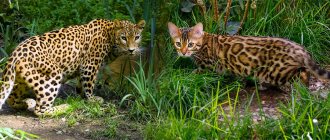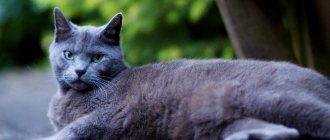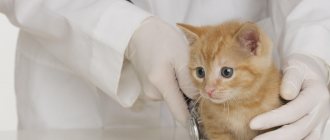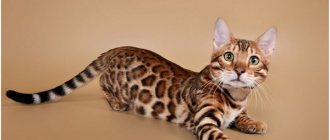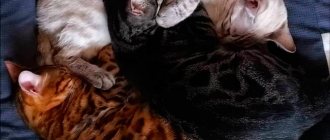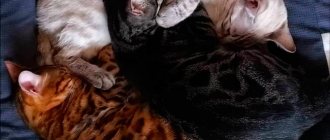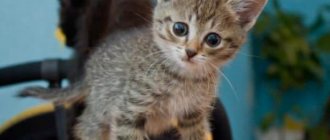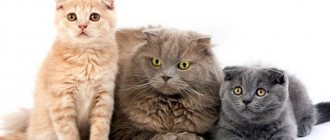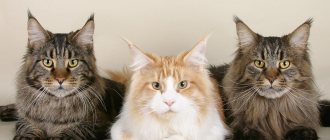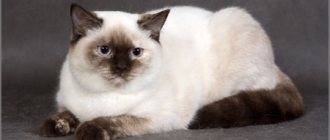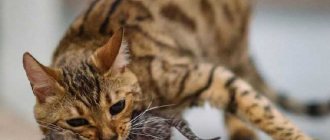An ugly kitten will become a beautiful animal
Phasing is a color distortion in small Bengals. Almost all pets at birth are decorated with stripes, rosettes, and spots. But after three to four weeks (sometimes earlier), the pattern on the fur becomes blurred and indistinct. Then long, stiff, grayish hairs appear. Because of them, the coat looks unkempt, too fluffy for the smooth-haired Bengal. He becomes different from his purebred parents.
Gradually the pets change color. The drawing will become clearer. The gray hairs will fall out, the hairs will become thick, smooth, and acquire a characteristic shine. The phasing process will be completed in approximately 4-6 months. In some individuals it can last up to eight months. The final result is noticeable within a year, sometimes even two.
Phasing is common to all felines in the wild. This is a defense mechanism that allows young predators to camouflage themselves and protects them from attacks by other animals. Little lion cubs first have a spotted coat, and young cheetahs in childhood wear a coat of long gray hairs, not at all similar to the luxurious skin of their parents. In nature, the phenomenon of phasing is quite widespread, it is found even in birds; it is partly reflected in the fairy tale about the ugly duckling.
In Bengal kittens, phasing occurs in different ways. It can be more or less pronounced, proceeds slowly or quite quickly. These characteristics do not in any way affect the final color development of this breed. The pattern, coat color, and glitter are determined genetically. When the allotted time has passed, the grown-up Bengal will shine with leopard-print beauty and meet all the expectations of the new owner.
The characteristics of this period depend on the color of the young Bengal. Pets with golden fur in early childhood can be very gray and inconspicuous. The silver cover is not that different from the final version. How do you know what the final color will be? Studying the characteristics of the parents may provide some insight. The shade of the fur and the shape of the spots will most likely be the same.
The kitten goes to a new home at three months. At this point, phasing in Bengals is entering its final stage, but the process is not over. Don't be disappointed in advance. The final formation of color will occur closer to the year. Some individuals require up to one and a half years for this. At four months it is already possible to draw some conclusions about the shape of the spots, possible disadvantages and advantages.
If a pet is taken into a home for love, and not for breeding, minor defects in the exterior can be ignored. Almost all Bengals are distinguished by their magnificent appearance. They also have a wonderful character, high intelligence, they are affectionate, and will make excellent companions.
“Bengal kittens have a very high need for communication; prolonged loneliness causes stress. If the owner does not have the opportunity to pay enough attention to the pet, it makes sense to think about purchasing another Bengal.”
Those looking for a future show champion or a good sire may want to wait a little longer. The older the pet, the easier it is to determine all the characteristics of its fur. Buyers unfamiliar with the phasing patterns of Bengals may experience considerable disappointment when they first see a reserved kitten.
But in the future, an exciting adventure awaits them, not familiar to all cat owners. They can watch how their favorite “ugly” kitten changes, how it gradually grows, develops, and turns into a magnificent leopard. Breeders recommend photographing Bengal pets more often. These pictures make a great story.
Owner reviews
We have a girl who is one year old and almost two months old. She has been with us since March 13 last year: COOL. Perhaps we were just lucky, the stars aligned and we found exactly our cat, Snowball with blue eyes. Moderately mischievous, not aggressive at all, sociable. If I understood correctly when I chose this particular breed myself, aggression is a defect of the breed, breeders must strictly monitor this point. We were only in two small nurseries - a child (11 years old) played with cats and kittens of different ages for quite a long time and did not receive a single scratch! And now, if a scratch happens, it’s extremely rare that they play or I forgot to do her manicure on time, mostly the cat just plays with her paws and doesn’t let go of her claws. I haven't had a single scratch the entire time. Dr. Kalinin came to see us in November and noted how patient the cat was and not at all aggressive. And after the operation, the cat became even more affectionate))))) She’s not stupid - she understands everything perfectly, looks you in the eye and also loves to talk, but it’s relevant and not stressful at all) In general, we were looking for a companion cat and we found one!
We have two boys, 2 years old and one year old. The character is different, the eldest is phlegmatic, can sleep all day, loves to watch us from the height of the closet, always meets and sees us off, loves guests (everyone, from the courier to relatives), silent (although recently he has become more talkative), always It helps if someone is doing something, he is everywhere, when my husband is changing pipes or I am ironing (he is not even afraid of a steam generator), he loves fresh air, he may not eat at the dacha if he understands that for this he needs to go into the house. The little one is choleric, demands attention with his voice, very loudly, if you sit next to him, he busily climbs onto your knees and curls up in a ball, purring loudly, does not like guests - he hides, can play for hours, but if he sleeps on the radiator, then little can wake him up , in general, he’s a loud guy, he’s a small mover. I agree about the aggression, there’s no aggression, I cut my nails, give me pills, give subcutaneous injections, clean my ears and what else they do with cats, no swaddling, no one scratches me, they just complain with their voices. Of course, they need company - a cat, a dog, a child, an adult, as long as someone is with them and plays.
I have a Bengal cat. Live carcass - about 7 kg. Character - choleric with an awl, it’s clear where. The voice apparatus is such that the neighbors can hear. Especially if the cat decided that he was underfed. He was born on April 1, which apparently influenced his character. We took it from a nursery, but our breeder has now left Russia. There was a funny big-eared miracle with a black tail. A medium-sized cat with a striped snow leopard color was born. Now I’ve calmed down a little, but until I’m three years old... This is the first cat I have ever climbed up the curtains to the curtain rod. He did this until he was 6 months old, then the cornice collapsed along with the cat. Anything that is poorly nailed down = a toy. All objects are played with and chased - car keys, apartment keys, grapes, teaspoons, daughter's hairpins. Then they find themselves in the most unexpected places. Hunter cat. He tracks prey, thinks over a plan, and then starts the hunt. Once I stole a pancake with jam from my husband, hid it and sat there guarding it half the night. I woke up from a growl - the second cat, a Scottish felt armadillo, came too close to the nesting site. There they discovered that the pancake was missing. He is also very sociable. He always talks, tells, proves something. He carries toys in his teeth and asks to play. And it’s better to play, because otherwise he will play himself with all sorts of destruction. My daughter is 6 years old, we have him with her 3. There has never been any aggression towards the child, only if accidentally hurt in a game. The only thing is that a visit to the veterinary clinic turned into a safari - to clean the cat’s ears, several adults held the cat, and his muzzle was tied up like a dog. It didn’t help much... In general, it’s an excellent breed if you have someone to play with.
Ticking and glitter
Some runners are characterized by ticking - coloring the hairs in several shades along the length. Sometimes this phenomenon causes some blurring of the picture. If the parents have low-contrast ticking of a gray or dark shade, the spots will not be very clear. There is a high probability that the kitten will inherit this feature.
Glitter, i.e. shine, not found in all Bengal cats. Individuals with a dark, brown color are characterized by a golden glow, while the coat of light-colored Bengals has a pearlescent or mica-like sheen. To win at exhibitions, glitter is not necessary. There is no such requirement in the breed standard. Bengals with matte fur look no less impressive. Character, upbringing, and intelligence are much more important.
“Bengal kittens are smart and curious. They actively explore a new home and any object that comes into their sphere of attention. Watching them grow up will bring many pleasant moments, regardless of color, glitter, or shape of spots.”
Types of drawings
During breeding of the breed, preference is given to an appearance close to the wild one.
The Bengal cat most closely resembles its ancestors precisely in the pattern on its coat, which is divided into 2 types:
The marble pattern is the brightest and most saturated. The color of the pattern is the same throughout the body, usually quite dark and not washed out. Bengal cats in marbled color are the most common and less valued than other species.
Spot and rosette have the same meaning in the Bengal code. At the same time, the pattern on the body is different, which is clearly visible in the photo.
Rosettes are slightly stretched, full or open rings that can be regular or irregular in shape, but never merge together. This color makes Bengal cats look like a leopard or snow leopard. A pattern of rosettes of similar sizes, located evenly over the entire surface of the wool, is valued more highly.
Different and beautiful
The colors of Bengal pets are very diverse. They are distinguished by the color of their coat and the shape of the pattern, which can be:
- spotted or spotted;
- rosette or rosetted;
- marbled or marbled.
On the muzzle there are dark stripes on the sides, they fold on the forehead into the shape of the letter M. A scattering of small spots or stripes on the neck, the same markings should be on the light belly. The tail is covered with dark rings, the tip is dark.
Color brown/black tabby/spotted, i.e. a spotted/rosette pattern on a golden background is considered classic and the most popular. The color of the rosettes is chocolate, black, dark brown. The background color can be orange or yellow, clearly contrasting with the pattern. The belly, whisker pads, inner side of the paws, chest, and chin are lighter than the rest of the parts. The ginger kitten with dark spots looks like a real leopard, only small.
Dark marble pattern (brown tabby/marble) is another well-known color version. The stripes should be predominantly horizontal on light colored wool. Marble is equipped with a darker edging. But round stains, called “bull’s eyes,” are considered unacceptable.
An interesting variety of dark color is ash, also known as charcoal. Contrasting pattern on a light, cold background. There are “spectacles” around the eyes, and the eyebrows are black. This variety is not yet officially recognized, but is awaiting registration.
Silver tabby Bengals are very different from their dark brothers, but they look amazing. On a light silver background there are ash-gray/black stripes, rosettes, and spots. There is a black edging around the nose, as well as lips and eyes. The belly and inner sides of the paws are lighter than the main background. The color is darker on the back. The contrast requirements between the background color and the design remain unchanged.
Designation of Bengal colors
| Code | Color characteristics |
| BEN n 24 | Spot or rosette on a golden background |
| BEN n 22 | Marble on gold |
| BEN ns 24 | Spot or rosette behind silver |
| BEN ns 22 | Marble on silver |
| BEN n 33 | Seal Links Point |
| BEN n 32 | seal mink tabby |
| BEN n 31 | Seal sepia tabby |
| BEN n 24 charcoal | Black drawing on a light background, no brown or yellow tints, no code |
| BEN n 24 melanistic | Often black, but any background is acceptable, visually monochromatic, rosettes visible from a certain angle, not recognized |
| BEN a 24 blue | Blue-gray pattern on a light blue background, not recognized |
Separately, it is worth mentioning snow bengals, which come in three varieties:
- sepia;
- mink;
- color point.
Sepia is the darkest option with a light golden or orange background. The stripes are slightly darker than the background. The tip of the tail and the pads on the paws are chocolate. Mink is lighter, the background of this color varies from sable with a golden tint to cream. The contrast between the background and the pattern is not as noticeable as with the Browns.
Snow Bengal kittens of these two species are born almost white. Before phasing begins, the pattern is very weakly expressed. By the time of puberty, rosettes, stripes, and spots will become noticeable and clear. A touching white kitten will turn into a bewitching beauty with green or aquamarine eyes.
“The mink and sepia snow colors differ very slightly visually, but are formed by different genes. Genetic testing may be needed to accurately determine the type.”
Snow Bengals of the Lynx variety are color-pointed, have darker spots on the tail, paws, ears, muzzle, and the color of the body is lighter. The background is ivory or cream, very light, the eyes are blue. Snow lynxes are born pure white, the pattern will appear later, often only towards the end of the first year.
Blue Bengals are very rare beauties that have not yet been officially recognized. This doesn't stop them from looking great. On a cool blue-gray background with a metallic tint, the dark gray pattern looks unique.
What to feed Bengal cats
If a small leopard has settled in the house, the issue of its nutrition comes first, since the health of this cat directly depends on its diet and improper nutrition will cause a malfunction of the entire body. A domestic cat cannot take care of its own nutrition, so the responsibility lies with its owners. The food must contain everything necessary for the full functioning of the pet. Drawing up a nutrition plan for a Bengal cat is not an easy or responsible thing, so it is better to get advice from a specialist on this issue.
Bengalis should not be fed food that has not been eaten by humans. If you neglect this rule, you will have to, at best, treat your pet’s diarrhea, or visit a veterinarian for more serious problems. It is better not to talk about the worst-case scenario.
At least seventy percent of the total diet should be meat. The rest should include carbohydrates, fats and vitamins. To diversify the diet, you can give your cat offal. Bones with cartilage will also help, but only very small ones - ones that can be chewed.
Despite the stereotype, you cannot often feed your pets fish with fish, and this restriction especially applies to cats - frequent consumption of fish can cause urolithiasis. In moderation, you can give sea fish, from which you first need to remove the bones. Eating such food twice a week is quite acceptable.
Cats love egg yolks, so there is nothing wrong with occasionally treating your pet to quail eggs. This can be done no more than once or twice a week. Cats also love milk, but some of them may be intolerant to this product. When planning dairy products in your cat’s diet, you need to control their absorption by your pet’s body. As for fermented milk products, veterinarians do not recommend offering them to Bengals.
Store-bought food is quite appropriate for feeding a Bengal cat - it can be used either dry or canned. This breed has an increased sensitivity of the digestive tract, so unless absolutely necessary, you should not experiment by switching the animal from one type of food to another. The same applies to the transfer from store-bought food to natural food and vice versa. Dry and wet food must be of the same brand - you must pay attention to the composition of the product. A good food is one in which it is not soy or grains that predominate, but a meat component. Dry food is a must, as it is an excellent preventative against the formation of tartar. Two or three times a week is enough for variety. When choosing canned food, you also need to pay attention to the composition. Fat content above twenty percent is contraindicated for Bengal cats.
Clean water is a prerequisite for the healthy functioning of a cat’s digestive system - dehydration should never be allowed. Since representatives of this breed do not really like to drink from a bowl, you need to organize a special fountain for them, or provide them with the opportunity to drink from the tap.
How to choose a pet
First you need to understand the purpose for which a new inhabitant will appear in the house. You can literally fall in love with a Bengal at first sight, the wild beauty of these cats is so amazing. Individuals that have been removed from breeding are usually taken into the family. Often, breeders spay or neuter before sale.
A high-class Bengal kitten intended for participation in exhibitions or breeding work will cost more. Such an activity will require a lot of time and effort, and it will be difficult to combine it with a full-time job and full-time care for one’s own family. Will the owner be able to provide everything needed? A sterilized Bengal will become a wonderful friend to children and will get along with other cats and dogs. When choosing the class of an animal, you need to be aware of the load that has arisen.
The purchase decision has been made, it’s time to move on:
- Choose a trusted nursery.
- Reserve a kitten.
- Make your home safe for your new pet.
- Purchase a tall play set, toys, drinking bowls, and feeding bowls.
- Meet a veterinarian who is willing to take care of your Bengal pet.
- Check with the breeder about the type of food, the brand of finished food, and the type of filler that the kitten is used to.
- Buy a convenient litter tray.
- Choose a place for feeding, lay a waterproof covering.
- Create a veterinary first aid kit.
The owner of a Bengal kitten must adjust his personal schedule. The new family member will need time to play and socialize every day. Outdoor walks need to be planned in advance. It is mandatory to use a harness and use medications that protect against ticks. Keeping a purebred Bengal is not easy, but he will give you a lot of joy and become a devoted friend.
Personality of Bengal cats
The appearance of the Bengal cat is associated with the leopard and is perceived as treacherous and aggressive. In fact, this is not at all the case - fluffy domestic leopards are good-natured and sociable, which, of course, cannot be said about their wild ancestors.
Bengals are extremely self-confident and independent, but obedient to their owners. These cats love people and truly enjoy being with their owners. If the owners are absent from home for a long time, the cat will think that it has been betrayed and abandoned - this can lead to the pet getting sick. The Bengali is suspicious of strangers, but he loves his owner and trusts him boundlessly. If you give him affection and love, you can get a hundred times more in return.
Representatives of this breed are playful and curious - they tirelessly walk around the house in search of adventure. Play is of particular importance for her, because physical activity is vital for this cat. This is why Bengalis have vertical obstacles installed in their homes.
Bengalis are extremely intelligent. They can be taught simple commands - for example, “take a toy” or “sit”. Most cats easily learn to use their owners' toilets - experts say this ability is explained by the habit developed by their ancestors, who urinated in bodies of water so as not to leave a smell.
Bengal cats are not only not afraid of water, but even love it - they often express a desire to help their owner wash the dishes by jumping into the kitchen sink, or to keep company in the shower. The leopard is famous for its fishing abilities, so its domestic relatives strive for water, realizing part of their instinctive desire to catch fish for food. These beautiful creatures also try to realize their other instincts - for example, to hunt. They love hunting and try to do it always and everywhere. In general, it is vital for Bengals to realize their wild natural energy, and ignoring this condition can lead to the appearance of psychological problems in the animal.
What makes the Bengal unique is that the breed standard describes the ideal temperament. When an animal demonstrates any inconsistency with this ideal, it is disqualified - this is how the future of the breed is taken care of.
How long do Bengal cats live?
Cats that have half wild and half domestic genes represent a very small percentage of all existing cat breeds. In the wild, Bengals live in the territory from Southeast Asia to the Far East and live very short lives - their age rarely reaches five years.
Their domestic relatives have a clear advantage in this matter. Provided they have loving owners, timely consultations with a veterinarian, a proper diet, and the opportunity to realize their energy, pet Bengals can live from twelve to fifteen years or even more.
Origin story
In the 60s of the last century, a young girl and biologist, Jean Mill, began a long work on breeding and distributing the Bengal breed. As an experiment, she planned to cross a Siamese with a Persian, but did not receive approval from her supervisor. After graduating from university, she continued her work on the Persian breed.
In 1961, on a business trip, she found herself in Thailand, where she was fascinated by the local fauna and became deeply immersed in its study. She was particularly affected by the problem of extermination of wild cats, which were larger in size than ordinary domestic cats, also distinguished by their beautiful leopard print coloring.
The real homeland of the Bengal cat is the USA. Poachers hunted representatives of this species for their skin, captured small kittens, and then sold them illegally, including to other countries.
Deciding to save at least one individual, Mill purchased a wild Bengal cat kitten and later brought it to her home in the USA, where they lived permanently. Thus, this breed first came to the New World. It was from there that their first representatives came. This first rescued animal was named Malaysia.
The cat was withdrawn, avoided contact with people and other cats, trying to find a secluded place in the house. In 1963, a mate was found for the cat, and the first kitten was born, which had a characteristic spotted color similar to the mother’s. The owner was very happy about this fact and began to closely study hybridization, crossing, and the peculiarities of breeding with other cat breeds.
She tried to get a social, kind cat with a Bengal coat color. When Malaysia's daughter, Kim-Kim, reached reproductive age, she was also inbred (with her father).
Soon, due to personal problems, the breeding process was suspended. After some time, Kim-Kim herself died. Malaysia ended up in a zoo, where she got the opportunity to live in conditions close to wild conditions.
Jean returned to her idea only 15 years later, studying the immune system, as well as a number of diseases. She isolated 9 hybrid females, who soon brought a litter of kittens that had a real leopard coloring. Burmese cats and Egyptian cat breeds took part in this process.
In 1982, a wild cat with good coat qualities, namely golden color, was purchased. This gene turned out to be dominant, which means it was easily passed on to its descendants. Gradually, wild cats began to be actively involved in breeding Bengals. By the 90s, the breed acquired its basic properties, color, and features.
At the moment, the Bengal cat breed is considered the most recognizable in the whole world; they take part in many exhibitions and competitions. They also gave rise to other breeds, such as toygers.
Question to an expert
What breeds of cats descended from the Bengal?
Currently, breeds descended from the Bengal cat are recognized in felinological communities: Serengeti and Toyger. Breeders continue to carry out their work, perhaps others will become known in the near future.
How much do Bengal cats cost?
How wonderful it is to come home and see how your faithful furry friend rejoices at your arrival! It is very easy to have an animal, but it is much more difficult to provide it with everything it needs for a happy life. Therefore, the solution to this issue must be approached with all responsibility - weigh all the arguments, think through all the details. If the decision has not changed, you can choose a breeder and prepare to meet your future pet.
Bengal cats that meet breed standards are considered elite. Therefore, the price for these kittens is appropriate. In Russia, the range of prices for this breed is quite large - from twelve to one hundred and twenty thousand rubles.
